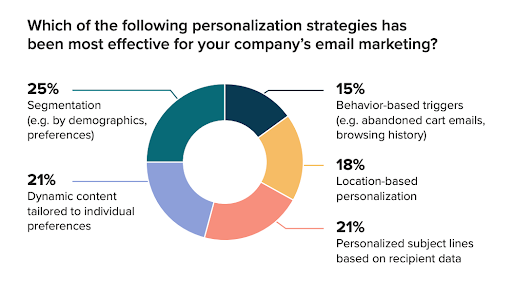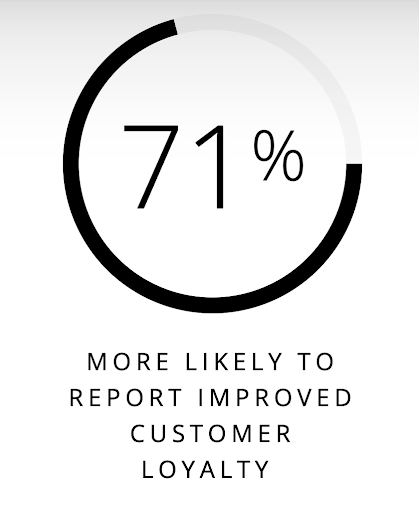Pros and Cons of AI-Powered Email Personalization for Your Campaigns
Most inboxes tell the same story.
A flood of subject lines competing for attention. Sales pitches that read like carbon copies. “Dear Customer” intros that make you wonder if the sender even knows who you are.
That’s the problem most marketers face today. Audiences tune out the noise. Engagement plummets. And budgets disappear into campaigns that never land.
Now here’s the twist …
Consumers don’t actually dislike marketing. They dislike irrelevance. They want marketing messages tailored to their likes, preferences, and values. That’s where AI-powered personalization plays an integral role.
AI can analyze behavior, purchase history, and even timing preferences to help transform bland mass emails into messages that feel like they were written for one person at a time.
Sounds like a dream, right?
Not so fast.
Like any technology, AI email personalization comes with its share of pros and cons. Let’s take a closer look at what they are and what to do about it. 👇
What is AI email personalization?
Consumers love personalization. In fact, 41% say they’re more likely to recommend a company when the experience feels consistently tailored to them.
But thanks to artificial intelligence (AI), personalization today looks nothing like it did a few years ago.
It’s no longer limited to adding a first name to an email subject line or segmenting people into broad groups. With AI, marketers can analyze browsing behavior, purchase history, and even timing preferences. This makes it easier to deliver messages that feel truly relevant handled with efficiency like Metrobi Newark courier services.
AI personalization also shifts personalization from reactive to predictive. It can spot signals that suggest what someone will want before they even go looking for it.
This leap forward is exactly why nearly three-quarters of business leaders believe AI will transform personalization and marketing strategies. (73% to be exact.)
But what is AI email personalization?
AI email personalization is the practice of using AI to customize every part of an email based on recipient data. We’re talking about everything from subject lines to intro paragraphs to the email design.
Instead of writing one outreach email and blasting it to a thousand people, you can tailor entire emails at scale, across different customer segments.
AI email personalization tools can do things like…
- Segment a contact list into meaningful groups (such as Northwestern University alumni, Inc. 5000 companies, or Apple Watch buyers).
- Craft personalized intro line options by pulling insights from Google Reviews, LinkedIn profiles, or company websites.
- Optimize send times with outbound flow logic, so messages land when recipients will most likely open them.
- Recommend products and services based on each recipient’s buyer history.
- Generate intro paragraphs or even full campaigns from scratch.
- Write multiple subject line options based on recipient data.
It’s no surprise, then, that 92% of businesses are already using AI-driven personalization for growth.
The Pros of AI-Powered Email Personalization
According to AI workplace statistics, AI-powered email personalization opens the door to higher engagement, better timing, and more loyal customers.
Let’s look at the biggest advantages and how to make them work for your campaigns. 👇
1. Better Engagement and Higher ROI
Let’s start with the obvious.
Personalized emails get more attention.
Open rates for marketing emails typically range from 20% to 30%. But when you personalize subject lines and CTAs, results soar. One study found that personalized call-to-actions perform over 202% better than generic CTAs.
And the ROI?
Email marketing is already famous for its return, with 35% of companies seeing an ROI of 36:1 or higher. Add AI-driven personalization into the mix, and those numbers only climb.
Why? Because you’re serving customers with information and offers that resonate with their interests, so they’re more likely to engage and convert.
Think about it like this …
Picture a customer who just stocked up on trendy winter vacation clothes from your store. They’re clearly heading somewhere cold and they appreciate looking nice.
Offering complimentary products, like winter perfumes, hats, and gloves to complete their ensembles, makes sense.

And this is important for marketers to understand, because customers reward relevance.
73% of consumers say they prefer brands that personalize experiences. But on the flip side, 40% get frustrated when emails feel irrelevant.

TL;DR: With AI, you can tailor emails so they’re hyper-relevant. This helps you avoid customer frustration, encourage better conversion rates, and increase customer lifetime value.
2. Predictive Insights that Hit At the Right Moment
One of AI’s biggest advantages is its ability to predict.
It can analyze behaviors like browsing history or abandoned carts, to figure out when to send an email, what product to feature, and even how to phrase the offer. This predictive approach means you’re no longer guessing when or what someone’s ready to buy.
That’s why 15% of companies say behavior-based triggers like this are their most effective email personalization strategy. Working this way aligns your outreach with customer behavioral patterns so you fit their rhythms.
You’re firing off the perfect follow-up email right when interest peaks.
3. Ability to Scale Without Burning Out Sales Teams
16% of marketers admit their biggest challenge is personalizing at scale.
This is because manually crafting personalized outreach emails for every prospect is a losing battle. Sales teams either churn out mass emails with generic intro lines or spend hours trying to customize subject lines and paragraphs one by one.
Neither approach scales.
AI email personalization tools change the equation. They don’t rely on a simple contact list with names and email addresses.
Instead, when integrated with a CRM with email marketing software, AI can tap into much richer data, pulling from:
- Public sources like LinkedIn updates, Google Reviews, or company news
- CRM data to use purchase history or browsing behavior
- Engagement data like past clicks or downloads
Combined, this gives you a more complete picture of the recipient without needing endless manual research.
AI then takes that data and turns it into hyper-personalized outreach emails. It might suggest a promotion after a recent purchase. Or highlight a product that matches past interests. (It could also time the message around the customer’s behavior.)
But the true value is its ability to do this at scale. It can pull this data all at once and generate hundreds (even thousands) of emails with this level of detailed personalization.
This means teams can focus on relationship building and strategic editing instead of repetitive writing. More on scaling in a bit.
4. Flexibility Across Personalization Strategies
Not every customer responds to the same strategy.
According to marketers, the most effective strategies for personalizing emails are:
- Dynamic content tailored to preferences
- Location-based personalization
- Personalized subject lines
- Behavior-based triggers
- Segmentation

But here’s the issue. It’s hard to roll out tons of different personalization strategies. Especially if you have a small team.
The good news is that AI can handle them all. And it can handle them at scale.
For instance, Writecream’s Chrome Extension lets you quickly test personalized subject lines in Gmail. But you can also use the tool to create dynamic content blocks for your next newsletter.
5. Stronger Customer Loyalty
Personalization builds loyal relationships.
Companies that deliver personalized customer experiences are 71% more likely to see an uptick in customer loyalty.

Why?
Because customers feel like the company sees and hears their needs.
And this is where AI’s ability to scale especially matters.
You can deliver that “this email is for me” feeling to thousands of people at once. That’s a huge push toward encouraging return buyers.
6. Better Workflow Efficiency
Email personalization at scale used to mean hours of manual work. Now, AI tools handle segmentation, scheduling, and even analytics.
AI-driven platforms can integrate with your workflow to pull in contacts from a Google Sheet or Excel file, scan for context, and instantly draft personalized lines. From there, email analytics platforms like EmailAnalytics (founded by Ajay Goel, CEO of EmailAnalytics) can measure performance, so you know what’s working. You could also mention how virtual office software helps teams centralize communication and streamline AI-driven workflows.
Automating like this takes the frustration and relentless trial-and-error out of email marketing.
(No more long debates over subject lines or wasting hours testing them manually. AI generates and tests multiple versions, optimizes send times, and picks the winner automatically.)
The Cons of AI-Powered Email Personalization
AI-powered personalization isn’t a silver marketing bullet. When the data is messy or the approach goes too far, the same tools that promise efficiency can backfire.
Here’s what you need to know:
1. Technical Setup and Data Quality Challenges
AI is only as good as the data it uses.
Duplicate records, outdated contact lists, or poorly integrated systems create chaos. And when AI works with messy inputs, it delivers messy outputs.
That’s why large companies and enterprises often lean on Oracle Managed Services Providers. These partners clean, connect, and secure data across CRMs, ERPs, and marketing platforms.
Without that foundation, AI personalization can do more harm than good.
Imagine a customer who already bought an Apple Watch getting another email pushing the exact same model. Or sending a customer an email congratulating them on their new job at Northwestern University … even though they left that role years ago.
These kinds of slips make your brand look sloppy.
2. Privacy and Compliance Risks
Personalization relies on data, which is regulated.
Mishandling it can result in GDPR fines, CCPA violations, and potential lawsuits.
And even when you’re compliant, there’s still the perception problem.
Recommending running shoes to someone who just signed up for a marathon? Smart. Mentioning their dinner at Salar Restaurant and Lounge last week? Creepy.
If personalization feels invasive, customers get weirded out. (Customers say it’s unnerving if they receive content that’s over-personalized.)
The answer is transparency.
Make it clear what data you’re using and why. And always give people options to opt out.
When done with intention, AI personalization can use data to build trust, instead of eroding it.
3. Robotic Tone and Cultural Missteps
AI can generate entire emails in seconds, but they don’t always sound human.
Without editing, the result can feel stiff and tone-deaf. Or hilariously off.
Popular culture references? Forget it. AI might try, but it often misses the mark.
For example, AI might drop a James Bond reference to a feminist who finds the franchise offensive. Or it might recommend the new steakhouse opening down the street to a vegetarian.
In these instances, personalization feels like a complete misstep.This highlights the importance of refining AI technologies, such as through AI chatbot development, to ensure that interactions are not only useful but also resonate appropriately with the target audience.
That’s why human oversight matters.
Let AI draft, but keep human writers and editors as part of the production process. They’re the real pros.
(This is especially important for sensitive contexts, like finance, healthcare, or cultural touchpoints.) Set up approval workflows so content marketing and sales teams can refine the message before hitting send.
4. Ongoing upkeep is essential
Models degrade over time if they’re not updated. And left unchecked, they’ll keep recommending old products, reusing stale subject lines, or repeating irrelevant offers.
This is when regular testing and analytics become vital.
Analytics platforms compare AI-generated campaigns with human-crafted ones, tracking metrics like open rates, click-throughs, and unsubscribe rates.
If email performance drops, it’s a sign your model needs a refresh.
Wrap Up
Email personalization powered by Artificial Intelligence is central to modern campaigns, with 89% of decision-makers saying it’s critical to business success.
The opportunity is massive: Better engagement, higher ROI, loyal customers, and workflows that scale without exhausting your sales and marketing teams.
But the risks are real, too.
Bad data, robotic copy, privacy pitfalls, and over-personalization can all undermine your efforts.
The smart move is striking a balance. ⚖️
Use AI email personalization tools to handle scale. But layer on human oversight to refine tone, add cultural nuance, and keep personalization from tipping into creepy.
And if you want your emails to hit the mark — personalized enough to feel genuine, but never intrusive — try Writecream for free today.
